Water cannon
A water cannon is a device that shoots a high-velocity stream of water. Typically, a water cannon can deliver a large volume of water, often over dozens of meters. They are used in firefighting, large vehicle washing, riot control, and mining. Most water cannons fall under the category of a fire monitor.
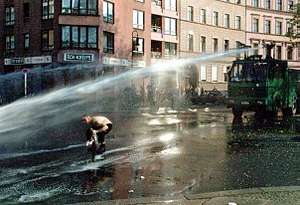
Firefighting
Water cannons were first devised for use on fireboats. Extinguishing fires on boats and buildings near the water was much more difficult and dangerous before fireboats were invented. The first fireboat deployed in Los Angeles was commissioned on 1 August 1919. The first fireboat in New York City was Marine 1, deployed 1 February 1891. There may have been other fireboats elsewhere even earlier.
Fire trucks deliver water with much the same force and volume as water cannons, and have even been used in riot control situations, but are rarely referred to as water cannons outside this context.
Riot control

The first truck-mounted water cannon was used for riot control in Germany in the beginning of the 1930s.[1]
The most modern versions do not expose the operator to the riot, and are controlled remotely from within the vehicle by a joystick. The German-built WaWe 10.000 can carry 10,000 litres (2,200 imp gal) of water, which can deploy water in all directions via three cannons, all of which are remotely controlled from inside the vehicle by a joystick. The vehicle has two forward cannons with a delivery rate of 20 litres per second (260 imp gal/min), and one rear cannon with a delivery rate of 15 litres per second (200 imp gal/min)
Water cannons designed for riot control are still made in the United States and the United Kingdom, but most products are exported, particularly to Africa and parts of Asia such as Indonesia.
Safety
Use of water cannon in riot control contexts can lead to injury or death,[2] with fatalities recorded in Indonesia (in 1996, when the cannon's payload contained ammonia),[3] Zimbabwe (in 2007, when the use of cannons on a peaceful crowd caused panic),[4] Turkey (in 2013, when the payload was laced with "liquid teargas"),[5] Ukraine (in 2014, with the death of activist and businessman Bogdan Kalynyak, reportedly catching pneumonia after being sprayed by a water cannon in freezing temperatures)[6] and South Korea (in 2016, when a 68 year old farmer died after injuries sustained by a water cannon the previous year).[7] Water cannons in use during the 1960s, which were generally adapted fire trucks, would knock protesters down and on occasion, tear their clothes.
On 30 September 2010, during a protest demonstration against the Stuttgart 21 project in Germany, a demonstrator was hit in the face by a water cannon.[8] Dietrich Wagner, a retired engineer, suffered damage to his eyelids and retinas[9], resulting in near-complete loss of his eyesight.[8][10] Graphic imagery was recorded of the event, sparking a national debate about police brutality and proportionality in the use of state force.
According to a report issued in the United Kingdom, using plastic bullets instead of water cannons was justified because the latter "are inflexible and indiscriminate", although several people had previously been killed[11] or seriously injured by plastic bullets.
Media effect
The presence of the media at riots has had a significant impact on water cannon use. There is much pressure on police departments to avoid bad publicity, and water cannons often play badly in the press. It is considered that this is a likely reason that they are not used more often in certain countries.
Confrontations that took place in the era of the American Civil Rights Movement, where water cannons were used by authorities to disperse crowds of protesting African Americans, has led to the demise of water cannons in the United States.[12]
Alternative payload
Dye
In 1997, pink dye was reportedly added to the water used by South Korean and Indonesian police to disperse a riot.[13] The implication is that they might use this mark to make it easier to arrest rioters later. The United Kingdom, which had sold the water cannon to Indonesia, condemned this practice (although the Royal Ulster Constabulary had used a water cannon with purple dye during The Troubles in Northern Ireland) but later approved the sale of further water cannons to them. Most modern water cannons are also capable of adding tear gas to the stream.
Electrified water cannon
In 2004, Jaycor Tactical Systems was experimenting with additives (salt and additives to reduce the breakup of the stream into droplets) that would allow electricity to be conducted through water. They have demonstrated delivery from a distance of up to twenty feet (6 m), but have not yet tested the device on people.[14]
Although referred to as an electrified water cannon, this experiment involved a water jet much less powerful than a water cannon.
Other types
Water cannon differ from other similar devices in the volume of water delivered in a given time, the nozzle speed, the pressure that it is delivered at, and to a lesser extent the total volume that can be delivered. They are also generally portable. The method of employment is also important in labeling a device a water cannon. Nevertheless, the distinction between a water cannon and other similar devices is fuzzy. For example:-
- Pressure washers generally produce an extremely high pressure stream where the power of the stream drops off significantly over a very short distance.
- Water pistols and other toys deliver much lower volumes of water at a much lower pressure.
- Ultra high pressure water jet cutters are used to cut a wide variety of materials including granite, concrete (see hydrodemolition), ceramics, fabric and even Kevlar.[15] One such cutter delivers 55,000 psi (380 MPa) through a nozzle 0.003 inch (76 micrometres) in diameter at 1 kilometre per second. This can cut a person in half at close range. There are reports of accidental deaths involving the industrial use of high-pressure water.[16]
Usage
Water cannon are still in use on a large scale in Chile, Belgium and other parts of the world.
Australia
The State of New South Wales in Australia purchased a water cannon in 2007, with a view to using it during an APEC meeting in Sydney that year.[17][18] It was not used.[19] It was the first purchase of a water cannon in Australia.
Germany
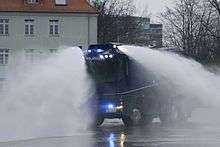
The annual riots on 1 May in Berlin, the Schanzenfest fair in Hamburg, which regularly ends in riots, or other demonstrations, are usually accompanied by water cannon, which support riot police. German communities use their water cannon in hot summers to water public parks. The most commonly used water cannon in Germany, which has more than 60 water cannons in total, is the Wasserwerfer_9000.
Turkey
The Turkish police water cannon TOMA has been used against protestors many times, including the 2013 protests in Turkey,[20] and are often present at protests of all sizes.
United Kingdom
Until 2014, although manufactured there, there were only six water cannons in the United Kingdom, all held by the Police Service of Northern Ireland. Water cannon use outside Northern Ireland is not approved, and would require the statutory authorisation of Parliament in England, or of the devolved assemblies in Wales and the parliament of Scotland. In June 2014, London's Deputy Mayor for Policing and Crime Stephen Greenhalgh authorised the Metropolitan Police to buy three second-hand water cannons from the German Federal Police. Mayor of London Boris Johnson said that the purchase had been authorised before Parliamentary approval, as the three cannons cost £218,000 to purchase and would require a further £125,000 of work before being deemed suitable for service, as opposed to £870,000 for a single new machine.[21] But after a study of their safety and effectiveness, Home Secretary Theresa May said in Parliament in July 2015 that she had decided not to license them for use.[22] They were sold in November 2018 with the intention that they were to be broken up for spare parts. [23]
United States
Truck-based water cannon, and fire hoses used as improvised water cannons, were used widely in the United States during the 1960s for both riot control and suppressing peaceful civil rights marches, including the infamous use ordered by Eugene "Bull" Connor in Birmingham, Alabama in 1963.[24] [25] The newsreel footage of police turning water cannons and police dogs on civilians—both student protesters and bystanders alike, including children as young as six—widely viewed as shocking and inappropriate and helped turn public sympathies towards civil rights. [26]
Hong Kong
Three truck-mounted water cannon, officially known as 'Specialised Crowd Management Vehicles', were purchased by Hong Kong Police in mid-2018, for HK$27 million - a sum that was criticised as excessive for the goods. The vehicles were frequently used by police on participants and bystanders during the 2019 Hong Kong protests. Blue dye was often added to the water to allow police to identify protesters. Pepper spray solution was also an ingredient.[27][28]
On 20 October 2019, police used a water cannon to target and shoot a small group of pedestrians standing outside Kowloon Mosque, in Tsim Sha Tsui, using blue-dyed water mixed with a pepper solution. A large number of Hong Kong residents spontaneously went to the scene to clean up, with the whole incident serendipitously resulting in an increased sense of inclusiveness among mainstream society toward Hong Kong's Muslim and other minorities.[29][30][31]
Mining

Water cannons are used in hydraulic mining to dislodge rock material or move sediment. In the placer mining of gold or tin, the resulting water-sediment slurry is directed through sluice boxes to remove the gold. It is also used in mining kaolin and coal.
Gallery
 Polish Police's Anti-Riot Detachment, filming a gathering. The film could later be presented during a trial as evidence. A water cannon is seen in the background.
Polish Police's Anti-Riot Detachment, filming a gathering. The film could later be presented during a trial as evidence. A water cannon is seen in the background.- Croatian Police water cannon CVT-6000
 German police water cannon WaWe 9000 content 9000 liter tank
German police water cannon WaWe 9000 content 9000 liter tank French National Police water cannon
French National Police water cannon Water cannon of the French National Police deployed to prevent rioting following Nicolas Sarkozy's election, 6 May 2007
Water cannon of the French National Police deployed to prevent rioting following Nicolas Sarkozy's election, 6 May 2007 Demonstration against G8 meeting, 5/9/2007
Demonstration against G8 meeting, 5/9/2007 A Dutch police water cannon.
A Dutch police water cannon. Tokyo Metropolitan Police Department Kidotai (Riot Police) water cannon unit. Base car is a Mitsubishi Fuso Fighter.
Tokyo Metropolitan Police Department Kidotai (Riot Police) water cannon unit. Base car is a Mitsubishi Fuso Fighter.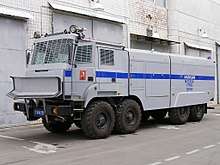 Moscow OMON riot control water cannon police vehicle "Lavina-Uragan" on Ural-532362.
Moscow OMON riot control water cannon police vehicle "Lavina-Uragan" on Ural-532362. Internal troops ABS-40 "Lavina" riot control water cannon on BAZ-6953 chassis
Internal troops ABS-40 "Lavina" riot control water cannon on BAZ-6953 chassis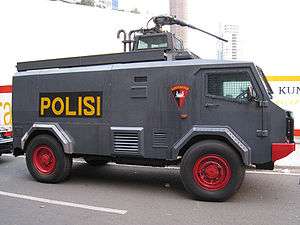 Indonesian Police riot control water cannon vehicle.
Indonesian Police riot control water cannon vehicle._-_Polic%C3%ADa_Nacional_de_Panam%C3%A1_(2011).jpg) Water cannon vehicle of Police of Panamá, friendly named "Pitufo" (Smurf).
Water cannon vehicle of Police of Panamá, friendly named "Pitufo" (Smurf).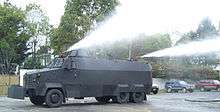 Riot truck used by Colombian Police. Made by ISBI. Holds 11,500 liters of water. It is Armored.
Riot truck used by Colombian Police. Made by ISBI. Holds 11,500 liters of water. It is Armored.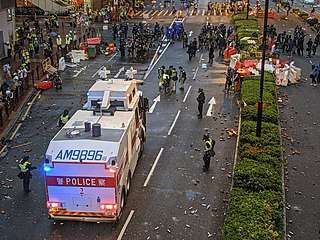 Specialised crowd management vehicle, the water cannon of Hong Kong Police Force
Specialised crowd management vehicle, the water cannon of Hong Kong Police Force
Other meanings
The term "water cannon" could also refer to:-
- Similar land vehicles used for firefighting
- Numerous large toys, for example images [32][33][34]
- Waterjet in hydraulic mining
- A type of railway wagon used to remove fallen leaves off the track: e.g. seen at Alexandra Palace on 25 October 2003
- Tool for powerwashing large construction equipment. See riveer.com for images, details and video
See also
References
- "Fedor Lapshin (Федор ЛАПШИН), Vodyannoye ohlazdhenie (Водяное охлаждение)". Trucks.autoreview.ru.
- Anna Feifenbaum (25 February 2014). "White-washing the water cannon: salesmen, scientific experts and human rights abuses". OpenDemocracy. Retrieved 15 July 2015.
- Sue Lloyd-Roberts (27 March 1997). "British arms help Jakarta fight war against its own people oveyr 2". The Independent. Retrieved 3 May 2016.
- "3 feared dead as police crush Zimbabwe protests". Archived from the original on 21 February 2007.
- "Substance in water cannons in Gezi Park protests harmful and criminal, experts say - LOCAL". Retrieved 3 May 2016.
- "Protester dies of pneumonia, allegedly caused by water cannons". Retrieved 3 May 2016.
- "Seoul National University Hospital corrects cause of activist's death". Korea Times. 15 June 2017. Retrieved 7 July 2017.
- "Wasserwerfer-Opfer bleibt auf einem Auge blind" [Water cannon victim blinded in one eye] (in German). 13 October 2010. Archived from the original on 5 February 2011. Retrieved 23 March 2011.
- "Injured Stuttgart 21 protestor could stay blind." The Local. 6 October 2010. Retrieved on 22 March 2014.
- "Blinded Stuttgart 21 protestor wants apology". 28 December 2010. Archived from the original on 5 February 2011. Retrieved 23 March 2011.
- "List of People Killed by 'Rubber' and 'Plastic' Bullets". 14 March 2011. Retrieved 26 August 2011.
- Fred Khoroushi (interviewee, President Alpine Armoring, Tony Long (writer), Bruce Nash (creator) (13 March 2003). "Non-Lethal Weapons". Modern Marvels. Season 9. Episode 9. History Channel.
- Indonesia and East Timor: Arms and security transfers undermine human rights. 3 June 1997. Amnesty International
- "Jaycor Water Cannon". Archived from the original on 26 June 2004. Retrieved 18 July 2011.
- "How a Water Jet Machine Works". JET EDGE Waterjet Systems.
- "OSHA Cites Contractor Following Employee's Death from Exposure to High-Pressure Water Jet Cutting Streams". OSHA Region 10 News Release. 11 December 2001. Archived from the original on 2 March 2004. Retrieved 21 February 2014.
- "Wet v wild: riot squad shows off its $700,000 weapon". Sydney Morning Herald. 21 August 2007. Retrieved 26 December 2008.
- http://www.treasury.nsw.gov.au/__data/assets/file/0020/4196/bp3_16police_n.rtf
- "0712 – WATER CANNON". Parliament.nsw.gov.au. Archived from the original on 12 March 2008. Retrieved 26 December 2008.
- Ece Temelkuran (3 June 2013). "Istanbul is burning". Occupy Wall Street.
- "Metropolitan Police given permission to buy water cannon". BBC News. 11 June 2014. Retrieved 3 May 2016.
- "Police water cannon use rejected by home secretary". BBC News. 15 July 2015. Retrieved 3 May 2016.
- "London water cannon sold at £300k loss". BBC News. 19 November 2018.
- 1963: The Defining Year of the Civil Rights Movement
- [https://www.nps.gov/bicr/learn/proclamation.htm "Presidential Proclamation Establishment of the Birmingham Civil Rights National Monument By The President Of The United States Of America"]
- Children Have Changed America Before, Braving Fire Hoses and Police Dogs for Civil Rights
- LCQ9: Specialised crowd management vehicles, Legislative Council question by Claudia Mo, June 13, 2018
- "Water cannon fired at defiant Hong Kong protesters".
- "Protesters help clean up Kowloon Mosque after police drench entrance with dyed water | Coconuts Hong Kong". 21 October 2019.
- Police say water cannon vehicle deployed to protect mosque, EJ Insight, October 22, 2019
- Amid protests for democracy, Hong Kong’s ethnic minorities strive to be heard, SCMP by Raquel Carvalho, 26 Oct, 2019
- V.P. Silva. "Rechargeable Watercraft With Motorized Water Canon". The UberReview.
- Archived 23 June 2006 at the Wayback Machine
- "Water Cannons". Raging Rapids.
| Wikimedia Commons has media related to Water cannons. |